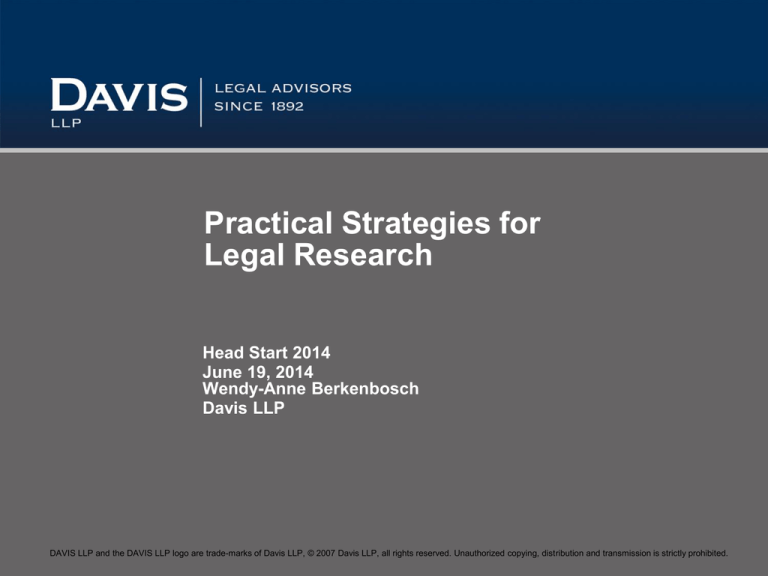
Practical Strategies for
Legal Research
Head Start 2014
June 19, 2014
Wendy-Anne Berkenbosch
Davis LLP
DAVIS LLP and the DAVIS LLP logo are trade-marks of Davis LLP, © 2007 Davis LLP, all rights reserved. Unauthorized copying, distribution and transmission is strictly prohibited.
Introduction
Who am I and why should you listen to me?
This presentation will provide you with a
roadmap for legal research problems, from
identifying issues to effectively communicating
results.
The Basics
Generally speaking, effective legal research
requires you to answer three basic questions:
1. What is the problem?
2. Where can I find the answer?
3. What is the answer?
The Basics
I advocate a research strategy that uses both
paper and online sources, but does not rely
exclusively on either.
This will allow you to take the benefit of both
resources while avoiding unnecessary risks or
limitations.
The Problem
Identifying the problem may depend on how
the research project has been assigned:
• The assigning lawyer identifies a narrow legal
issue without giving you the facts;
• The assigning lawyer summarizes the facts and
identifies the issues; or
• The assigning lawyer gives you the file
materials and asks you to identify the relevant
facts and issues.
The Problem
If you are asked to identify the legal issues on
your own, consider these strategies:
• Law school course subjects;
• Causes of action, defences or relief sought;
• Brainstorm or word associate based on relevant
facts; and
• Use indexes from secondary materials like the
CED or textbooks.
The Problem
Regardless of the nature of the assignment, in
order to provide an effective product, you must
understand what you have been asked to do.
If you are given written instructions,
congratulations! If not, listen carefully and
take notes.
Don’t be afraid to ask questions. If you are
intimidated, ask another student or an
associate.
The Problem
Address practical considerations, like time
lines and cost limitations, at the outset.
Keep notes of issues that occur to you while
you are in the midst of your research.
If you find that you need clarification along the
way, ask for it.
Don’t be afraid to be creative, but make sure
you talk to the assigning lawyer.
Finding the Answer
The key to legal research is not knowing the
law, it’s knowing where to find the law.
Use practical and consistent research
strategies. Consider using checklists to
ensure you are being thorough.
Start with general legal principles then move to
progressively more specific sources.
Starting Points
Start with the basics.
You have to understand the area of law you are
researching in order to be effective.
Starting Points
Use textbooks and other secondary sources
like the CED and the Canadian Abridgement to
give you a basic understanding of general
legal principles.
These sources can also direct you to other
sources.
Don’t ignore the footnotes: they contain
valuable citations for articles and cases that
may be relevant.
Starting Points
Consider whether your problem has a statutory
element.
If so, note up the legislation in question to find
applicable case law.
If you’re not sure, don’t be afraid to browse the
list of statutes.
Watch for changes to legislative language and
numbering.
Starting Points
Where your problem involves issues of
interpretation, check dictionaries and words
and phrases resources.
Recent articles can also provide general
principles, case comments and alternative
methods of analysis. Keep in mind that the
views of the author may not reflect the current
state of the law.
Starting Points
Check the CD Rom or online resources
available at your firms and libraries.
Check LESA, CBA and other seminar
materials, which are often prepared by leading
practitioners.
Next Steps
Once you have a basic understanding of the
problem, move to the case law.
If you have gleaned leading cases from the
secondary sources, read them carefully. Pay
particular attention to factual or legislative
similarities or differences.
Watch out for cases that contain multiple
judgments, as it can be difficult to determine
the majority position on various issues. A
chart can be helpful (seriously!).
Next Steps
Where possible, focus on law from the
applicable jurisdiction, particularly where your
issue involves a matter of procedure or is tied
to statute.
Keep in mind that case law from certain
jurisdictions carries more weight than case law
from others.
Note up, note up, note up!
Next Steps
If there are no obvious leading cases,
formulate a search strategy.
Use key words and resource lists from
textbooks and other secondary sources, such
as the Canadian Abridgement and CED keys.
Browse the indexes in topical case reporters.
Next Steps
Conduct online searches, keeping in mind the
limitations of the databases you are using.
Think about your search terms ahead of time,
using the key words you have come across in
other sources.
Use general searches and digest databases to
narrow your focus, then move to more specific
searches.
Next Steps
Be aware of the different fee schedules in
place for online resources.
Review digests or headnotes online to avoid
unnecessary printing charges.
Use the most cost effective ways of printing
cases.
Analysis
Legal research does not end with finding the
law.
Apply the law to the facts underlying the
problem you have been given. If you haven’t
been given the facts, ask for them or note that
in your memo.
Don’t be afraid to reach a conclusion, but be
sure to back it up.
Analysis
Make sure your analysis flows logically from
start to finish:
• What are the elements of each issue or cause of
action?
• What legal principles apply to each?
• How do the facts relate to each issue and the
legal principles?
• Example: interlocutory injunctions.
Analysis
Think about what will be useful to the lawyer
reviewing your work, the client and the judge
(if applicable):
• Why are the cases you are citing important?
• What are the similarities and differences
between the cases and your facts?
• Are you applying existing legal principles or
extending the law to apply to your
circumstances?
Analysis
Do not ignore case law that is unfavourable to
your position.
Regardless of any ethical obligations that may
apply, from a practical perspective, both your
case and your reputation are best served if you
can address and distinguish unfavourable law.
The Finished Product
Provide your answer in a comprehensible and
useable format:
• Introduction (what the memo is about);
• Brief Conclusion (if the memo is more than a
few pages);
• Facts;
• Issues;
• Analysis (with subheadings for each issue);
• Conclusion and Recommendations;
• Sources Consulted.
The Finished Product
This format forces you to follow a logical
progression.
It can also be used as an outline, which will
help you organize your thoughts and
approach.
The Finished Product
Use your subheadings effectively. For
example, I would organize the analysis section
of a memo on interlocutory injunctions as
follows:
• What is the test for an interlocutory injunction?
• Is there a strong prima facie case or serious
question to be tried?
• Can we establish irreparable harm?
• What is the balance of convenience?
• Do we need an undertaking?
The Finished Product
Give yourself time to edit your work. If you
read it again in a day or two, you will be better
able to identify areas that need work.
Avoid overly long quotations by paraphrasing
instead. Many readers simply skip over large
sections of quoted text.
The Finished Product
Always consider the end use of your research
project.
If you are drafting an opinion letter that will go
to a client, ensure that it is suited to that
purpose.
The Finished Product
Most clients want a practical and expert
application of the law to their particular
circumstances.
They do not want pages of esoteric discussion
on the evolution of the Rule of Law in Canada.
The Finished Product
On the other hand, if you are drafting a
comprehensive research memo for another
lawyer, you can (and likely should) provide
detailed analysis.
Research memos should contain more pure
law, including specific legal sources and full
citations for secondary sources and cases.
Lawyers will cut and paste your work into
opinion letters or briefs, so if possible create a
product that can be used in this way.
Practical Tips and Tricks
Use the resources that are available to you.
Librarians are invaluable sources of
information and will always know more than
you do about legal research.
Don’t reinvent the wheel: check firm memo
banks and databases to determine if anyone
else has examined the same issue, which may
give you an effective starting point.
Practical Tips and Tricks
When you are preparing an opinion or a memo
for another lawyer, ask his or her assistant for
a precedent so you can use an appropriate
format.
Consider including a short conclusion at the
beginning of long opinions or research memos
so that the answer is readily accessible.
Practical Tips and Tricks
Use proper citations. The Court accepts
reliable electronic citations, but also requests
that a parallel reported citation and the neutral
citation be provided if available: see Queen’s
Bench Notice to the Profession dated February
1, 2002.
Use pinpoint references for quotes, preferably
to paragraph numbers.
Practical Tips and Tricks
Anticipate that you will be interrupted in the
midst of a research problem.
Prepare case summaries as you go, by
dictation or on paper or sticky notes that you
can attach to the cases.
Practical Tips and Tricks
Keep records of the sources you have
consulted. If you’re using looseleaf editions,
note the date of the most recent update. This
will allow you to readily note up your research
at a later date.
Keep track of your online searches as you
conduct them in order to prevent duplication.
Practical Tips and Tricks
Keep your research material together,
including your notes and any cases you’ve
reviewed. Keep it with the file!
Create and maintain a personal precedent
system, whether electronic or in paper.
Keep a folder of commonly cited cases.
Resources
Alberta Courts Website: albertacourts.ab.ca
Research texts:
• D.T. MacEllvan, Legal Research Handbook, 5th ed.
(Toronto: Butterworths, 2003)
• M. Iosipescu, Legal Writing and Research Manual, 6th ed.
(Markham: LexisNexis Butterworths, 2004)
• J. Castel, The Practical Guide to Canadian Legal
Research, 2nd ed, (Scarborough: Carswell, 1996)










